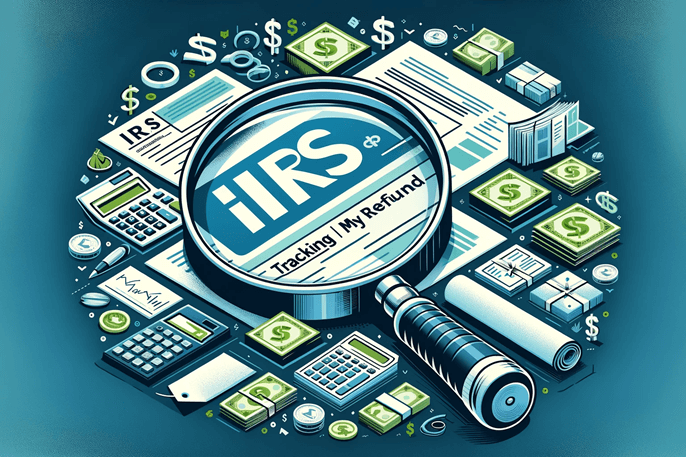In the ever-evolving world of taxes, staying informed about your refund status can be both challenging and essential. This article dives deep into the intricacies of tracking both federal and state tax refunds. Whether you’re a first-time filer or a seasoned taxpayer, this guide will provide valuable insights into the IRS processes, timelines, and tips for maximizing your refund.
Where’s My Refund – What is IRS Track My Refund Status Checker?
The IRS Track My Refund Status Checker, commonly known as “Where’s My Refund,” is a pivotal tool for taxpayers eager to track their federal or state tax refunds. Designed for both simplicity and efficiency, this online platform or mobile app allows users to check the status of their tax returns by entering basic information, such as their social security number and filing status. It’s especially useful for those expecting significant refunds, perhaps due to credits like the child tax credit.
While the tool is straightforward, it’s important to note that the refund may be delayed for various reasons, such as the processing of an amended tax return or IRS internal reviews. Taxpayers can use this tool to track the progress of their refund, from the moment their return is received until the refund is sent. The IRS may update the status regularly, making it a reliable way to check on your refund. Additionally, for those who need to check on the status of a state refund, many state tax agencies offer a similar refund tracker or refund tool, which can be accessed using relevant IRS forms and guidelines. This makes it easier for taxpayers who have filed their return and are eagerly awaiting to receive their tax refund.
What Is a Tax Refund and How Is It Calculated?
Understanding the Basics of Refunds
A tax refund is the amount returned to a taxpayer when their tax payments exceed their actual tax liability. This section explains the calculation process, considering factors like withholding amounts, tax credits, and deductions.
Factors Influencing Your Refund Amount
Various elements, including your filing status, income tax, and eligible credits like the child tax credit, play a crucial role in determining your refund amount. Learn how each factor contributes to the final figure.
How Can You Check Your Federal Tax Refund Status?
Using the IRS “Where’s My Refund?” Tool
Discover the most efficient way to track your federal tax refund using the IRS’s online tool. This tool offers real-time updates on the status of your refund.
What Information Do You Need to Check Your Status?
Learn about the essential details, such as your social security number and filing status, required to use the IRS refund tracking facilities effectively.
Tracking Your Tax: Checking Your State Refund Status
State-Specific Processes for Refund Tracking
Each state has its unique process for tracking tax refunds. This section guides you through finding and using your state’s specific refund status tool.
Understanding the Variations in State Refund Timelines
State tax refunds can differ significantly in processing times. Discover what factors influence these variations and how they affect your refund.
Why Might Your Tax Refund Be Delayed? What Affects the Tax Refund Date?
Common Reasons for Refund Delays
Delays can be frustrating. Understand the typical causes, such as errors in your tax return or issues with direct deposit information, that might slow down your refund.
Handling Amended Returns and IRS Audits
Amended returns and audits can significantly impact your refund timeline. Learn how to navigate these situations and what steps you can take to expedite the process.
Direct Deposit: The Fastest Way to Receive Your Refund
Setting Up Direct Deposit for Your Refund
Direct deposit is the quickest method to receive your tax refund. This section provides a step-by-step guide on setting it up with the IRS and your state tax agency.
Benefits of Direct Deposit Over Traditional Checks
Understand the advantages of direct deposit, such as enhanced security and speed, compared to receiving a physical check.
What to Do If Your Refund Is Smaller Than Expected?
Analyzing the Reasons Behind a Reduced Refund
Sometimes, the refund value might be less than anticipated. Explore the common reasons, including tax debts or adjustments made by the IRS.
How to Dispute a Refund Amount with the IRS
Learn the process of disputing your refund amount with the IRS, including contacting tax professionals and using IRS form guidelines.
Max Refund: Essential Tips and Tricks for Maximizing Benefits
Strategies for Maximizing Future Refunds
In 2023, as tax time approaches, it’s essential to be well-prepared for both your federal and state tax filings. One key strategy is staying updated with your IRS tax refund status. By regularly checking your IRS or state return status, particularly if you’re due a refund, you ensure you’re on top of any changes or updates. This vigilance is crucial, especially when you expect your federal tax refund or are tracking a state refund.
Leveraging tax preparation software can be a game-changer in your tax filing process. Tax software not only simplifies tax return and refund calculations but also helps in tracking the status of your federal and state refunds. It’s a tool that aligns with the IRS’s push for e-filing, which is the fastest way to get your refund processed. Additionally, these platforms often include tax tips and advice, helping you understand the nuances of tax laws and maximize your potential refund.
Utilizing Tax Software and Professional Advice
In the journey to secure your max refund, understanding the importance of professional tax advice cannot be understated. A qualified tax pro can offer personalized guidance, especially in complex situations like handling a tax audit or deciphering a letter from the IRS. They can also assist you in using IRS forms correctly and advise you on the status of your tax return, ensuring you adhere to all federal income tax guidelines.
Professional advice is particularly beneficial when you need to contact a tax agency or call the IRS for specific inquiries, like clarifying the status messages received on the “Where’s My Refund” or “Where’s My Refund” portals. These experts can also provide insights into the refund processing times and what it means when your refund is accepted by the IRS.
Moreover, with a tax professional’s help, you can navigate through the complexities of online tax systems and IRS online services, ensuring that every part of your refund, especially if it involves an income tax refund, is accounted for. They can guide you on how soon the IRS processes refunds and what it means for your tax situation.
In summary, maximizing your refund potential in 2023 involves a combination of staying informed about your IRS refund status, utilizing efficient tax software, and seeking expert tax advice. This approach not only helps in understanding the actual tax implications but also ensures that your refund possible is maximized, whether it’s a federal or state tax refund. Remember, the key to receiving the max refund lies in how effectively you track the status, manage your tax filing, and respond to any IRS issued directives or updates.
Understanding IRS Refund Status Messages: What Do They Mean?
Decoding the Different Status Messages from the IRS
The IRS provides various status messages about your refund. Learn what each message means and the expected actions or timelines they imply.
What to Do If Your Refund Status Is Unclear
If the status messages are ambiguous or your refund seems stuck, this section provides guidance on how to proceed, including when to contact the IRS.
The Role of Tax Credits in Your Refund Status
Impact of Tax Credits on Refund Amounts and Timelines
Tax credits like the child tax credit can significantly affect your refund. Understand how these credits are factored into your refund calculation and processing time.
Navigating Changes in Tax Credits and Their Effect on Refunds
Tax credits can change yearly. Learn how to stay updated on these changes and their potential impact on your tax refund.
Preparing for Next Year: Filing Your Return Effectively
Best Practices for Efficient Tax Filing
Proper preparation and filing can streamline the refund process. Discover the best practices for filing your return, from organizing documents to understanding the latest tax laws.
Utilizing IRS Resources and Tools for Filing
The IRS offers various resources and tools to assist taxpayers. Explore these resources to ensure an efficient and accurate filing process.
Key Takeaways of Checking Your State Tax Refund
- Stay Informed: Regularly check your refund status using IRS and state-specific tools.
- Understand Delays: Recognize common reasons for delays in refund processing.
- Optimize Refunds: Employ strategies and seek professional advice to maximize your refund.
- Prepare Effectively: Organize documents and understand tax laws for efficient filing.
Understanding and tracking your tax refund can be a seamless process with the right knowledge and tools. This guide provides the essential information needed to navigate the complexities of IRS and state tax refunds, ensuring a stress-free tax season.



